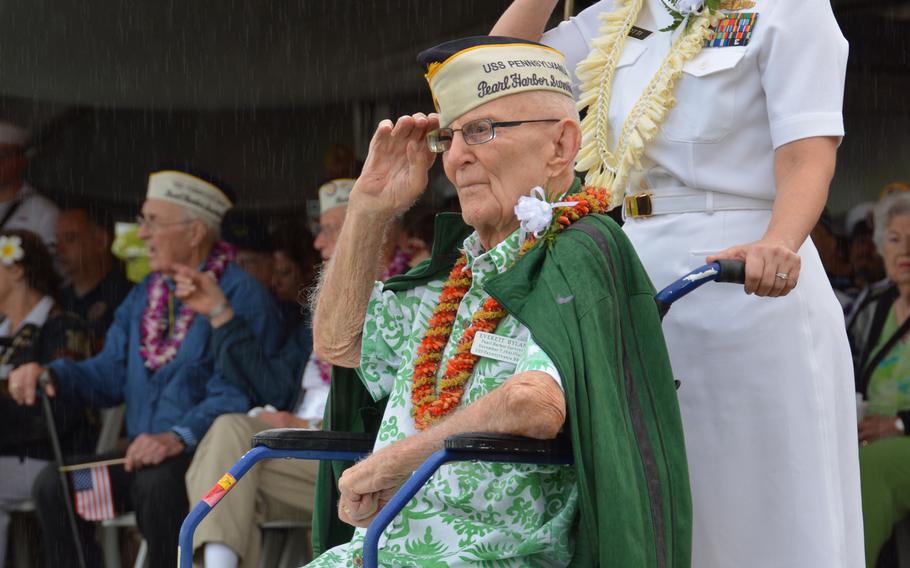
Everett Hyland, a Pearl Harbor survivor from the USS Pennsylvania, represents his fellow survivors in a salute to the USS Michael Murphy sailing through Pearl Harbor, Friday, Dec. 7, 2018, during a ceremony commemorating the 1941 surprise attack. (Wyatt Olson/Stars and Stripes)
PEARL HARBOR VISITOR CENTER, Hawaii – An atmosphere of fading voices and vanishing time permeated the Friday morning ceremony commemorating the 77th anniversary of the Dec. 7, 1941, surprise attack on Oahu by Japan.
For the first time, no survivors from the USS Arizona attended the annual event. The five who remain living, all well into their 90s, were not robust enough to make the journey to Hawaii.
Meanwhile, this was the first commemoration that did not include a visit to the USS Arizona Memorial by attack survivors and other dignitaries. The memorial, which stands in the harbor above the sunken ship upon which 1,177 men died that day, has been closed for most of the year for repairs to the site’s floating dock.
“The voices are fading,” Jacqueline Ashwell, superintendent of the World War II Valor in the Pacific Monument, told the audience of about 700 after noting the recent deaths of several men renowned for their connections to Pearl Harbor.
Ray Emory, a former USS Honolulu sailor who fired his .50-caliber machine gun at the attacking Japanese planes, died in August at age 97. In recent decades he successfully fought to have the graves of unknowns from the USS Oklahoma, sunk during the attack, exhumed and identified.
Ray Chavez, the attack’s oldest survivor, died of pneumonia on Nov. 21 at age 106.
And former President George H.W. Bush, a Navy aviator in World War II, died last week. He spoke at Pearl Harbor on the attack’s 50th anniversary, telling the audience that those who died here that day “live forever in our memory, reminding us gently, selflessly, like chimes in the distant night.”
“President Bush will forever be a part of the history of Pearl Harbor, a history that is still being written,” Ashwell said.
She urged the audience to take a moment to imagine the scene of Pearl Harbor during that attack, a Sunday morning filled with “explosions, chaos, smoke, flames.”
“Some of you don’t have to imagine,” Ashwell said. “You were here and witnessed it firsthand. We are truly blessed to have you here today to help us remember.”
Among the roughly 20 attack survivors seated in the front row was Tom Berg, a 96-year-old who had joined the Navy right out of high school in 1940. He was below deck in Boiler Room 7 on the USS Tennessee, which was moored on Battleship Row beside the USS West Virginia, when the attack began.
Berg’s job was to communicate via phone with a sailor on the navigation bridge.
“He was describing what was going on,” Berg said. “He told us when the Oklahoma turned over, when the West Virginia was sinking and listing.”
When the Arizona’s magazine blew up at about 8:10 a.m., the concussion drove smoke down the Tennessee’s pipes into the boiler room, burning off the eyebrows of some men, he said. The Tennessee’s stern was engulfed in flames from the Arizona’s burning fuel oil.
“I was scared stiff,” Berg said of that morning. He fashioned a makeshift plumb bob with string he found, hanging it from walkway grating above him.
“I wanted to see if the ship was rolling,” he said.
One of Berg’s friends was killed when a bomb hit the anti-aircraft gun he manned on the Tennessee’s deck. Shrapnel from another bomb that hit the Tennessee flew over to the West Virginia, killing its commander.
A few days later, Berg said, the bodies of the dead in the harbor began rising to the water’s surface. “Only the back would show, like a pillow,” he said. “Small liberty boats were picking them up. They took them to temporary storage in the Navy recreation center, where the visitor center is now. They put them all in the big swimming pool.”
Speakers during the ceremony stressed that the sacrifices made by the men who fought and died on Dec. 7, 1941, must not be forgotten as the few remaining survivors fade into history.
“We can never forget the heavy price paid 77 years ago,” said Adm. Phil Davidson, commander of U.S. Indo-Pacific Command. “Twenty-one vessels damaged or sunk; 170 planes destroyed; more than 2,400 dead and 1,200 wounded. Soldiers, sailors, Marines, airmen and civilians.”
Ashwell closed her remarks by addressing all who died in the attack, all the survivors who have passed on in the 77 years since and all the veterans still alive and able recall the events of that day.
“To all of you I say, please, do not worry,” she said. “For so long as there is a United States of America, a flag will fly over the USS Arizona Memorial, and the National Park Service and the U.S. Navy will continue to tell your story. Your unconquerable spirits will live forever.”
olson.wyatt@stripes.com Twitter: @WyattWOlson